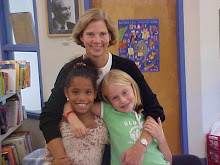At the recent
Next World Conference, Thomas Freidman hosted a panel on challenges in education. Tony Wagner from Harvard's Innovation Lab said, "Content knowledge has to be engaging to kids. If kids
aren’t motivated, you can pour content knowledge in their heads and it
comes right out the other ear." Richard Miller, president and professor at Olin College said he hoped
that "...students will leave school thinking about how they can change
the world, not about what job they will get."
STEM
projects are inherently motivating to most kids and there is a move in education circles to emphasize them as vehicles for igniting imagination, cooperation and innovation. We have certainly seen this to be true at Parker. From the middle school's Engine Project, Rube Goldberg Challenge, STEM week and First LEGO League competition to designing water wheels in second and third grade, students love these projects.
There are also many projects beyond STEM that engage students. It seems to be immersion and choice within a topic that are the most motivating factors. Students, when given agency within a framework, gleefully embrace the biggest and most complex - or even small or tedious - challenges.
Witness the recent areas of study across the grades at Parker. Students worked in and out of school, in their spare time, feverishly near the end, to build models of historic regional landscapes (2-3) or displays of historic change-makers (4-5). Kindergarteners carefully researched, drew, wrote, and invited peers and parents to an exhibition about communities. 8th graders honed speeches and coordinated photographs, made soup and researched world hunger to mount their complex and compelling Empty Bowls event.
Basic skills like reading, writing, and problem solving were practiced. The content knowledge gained was topic-specific and rich in detail and nuance. Students also learned those larger lessons that are embedded in the school's mission: passion, curiosity and confidence. And they practiced values like responsibility and ethics.
In a curriculum designed around projects of all types, students get to do work worth doing. What a difference it can make!
























































